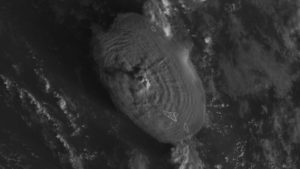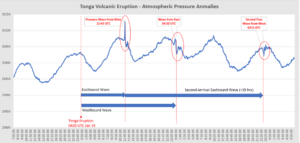
On January 15, subscribers to the V.I. Territorial Emergency Management Agency’s emergency alert system received a notice from the Pacific Tsunami Warning Center in Hawaii announcing there was no tsunami threat from a Tonga volcanic explosion.
Since U.S. Virgin Islands residents were told to expect only minor sea-level fluctuations from this event occurring halfway around the world, most of us went about our business.
However, the report piqued the interest of David Silverman, a resident of St. John who has a strong interest in science and natural phenomena. He decided to take a closer look at the readouts recorded by weather instruments at his home. Sure enough, he saw “a very noticeable jump” in atmospheric pressure in Coral Bay corresponding to the time it would take for the blast to be felt in the Virgin Islands.
“What goes around, comes around,” goes the old saying, and this turns out to be true – and more than once – for this event. The following is a detailed explanation written by Silverman about what he discovered.
The Tonga Eruption – A Sound Heard Round the World
Drop a pebble in a pool of water and a ripple will expand outwards in a circular pattern covering all points on the surface until it reaches the edge of the pool. Smaller secondary ripples and reflections from objects will disturb the surface until, over time, the entire pool quiets back down again.
In the early morning hours of January 15, 2022, an underwater volcano near the South Pacific island of Tonga erupted. The enormous explosion accompanying the eruption created an acoustic shock wave in the earth’s atmosphere analogous to the pebble in the pond. But, unlike a flat, finite pool of water, the earth is a sphere with no boundaries and that shock wave expanded until it encircled the earth.
This is exactly what happened with the underwater explosion from the Tonga-Hunga-Haʻapai volcano. The intense sound of the eruption created a gigantic acoustic pressure wave that emanated in all directions from the point of the explosion. Waves in water are detected by variations in the height of the water, but a wave in air is detected by variations in air pressure, and so this acoustic wave was detectable by barometers – devices that measure atmospheric pressure – all over the world.
The velocity of sound in warm air is around 760 miles per hour. This is equivalent to just over 1100 feet per second, which is why you can count the seconds between a flash of lightning and the sound of thunder, and every five seconds is equivalent to about one mile (about 5,280 feet). In the case of the Tonga explosion, the acoustic pressure wave radiated outward in all directions from Tonga at a speed of just over 700 miles per hour, or 1130 kilometers per hour.
St John is 12,785 kilometers from Tonga, in a straight line. The pressure wave from the Tonga explosion, traveling at 700 mph should have taken 11.3 hours to reach St John. The eruption, which was visible from earth-orbiting satellites, occurred at 04:20 UTC (Universal Time). If you add the time to reach St. John, we should have seen a pressure wave at 15:38 UTC. Since local time is four hours earlier than UTC, this is equivalent to 11:38 a.m. on St. John.
As part of my regular weather monitoring, I record wind speed, temperature, humidity and barometric pressure using some simple amateur weather devices. My “Vantage Vue” weather station records barometric pressure every five minutes, and this data is stored in a database. I have a second device – a Weatherflow Tempest – which records pressure every minute, and I compare the two measurements to make sure there are no errors in the data.
Later in the day of the Tonga explosion, I examined my recorded barometric pressures, and much to my surprise there was a very distinct pressure “anomaly” at 11:43 a.m. on January 15. The “normal” barometric pressure varies up and down every day, much like the normal tides. Normal changes in pressure are minimal and smooth, so a distinct “jump” in pressure is very noticeable. The chart below shows the first observed pressure anomaly, at 11:43 a.m. on Saturday, January 15.

Getting back to the image of the earth and an expanding circular wave, there are two straight lines from St John to Tonga. The first is the line to the west, the shortest distance, of 12,785 kilometers. But you can also travel east, across the Atlantic, Africa, Asia, and the South Pacific, and reach Tonga in that direction. Since the circumference of the earth is 40,200 kilometers, the distance from St John to Tonga, traveling east, is 27,415 kilometers. At 1,130 km/sec, the sound traveling from that direction should have reached us in 24.25 hours. That amount of time following the 0420 UTC Jan 15 explosion would have been 0435 UTC, or 0035 Local Time (St John) on Jan 16.
The next day I again examined my pressure recordings, and just as predicted, the longer distance wave from the explosion had reached St. John just after midnight, at 12:30 a.m. on Jan. 16. So this second pressure anomaly was the sound of the explosion traveling almost 30,000 kilometers, across the South Pacific, Asia, Africa, the Atlantic Ocean, and reaching St. John.
I then wondered whether we would continue to see the pressure wave as it continued around the world for a second time. And although the signal was more muted and spread out, my instruments recorded the first wave making a second pass over St John, having traveled one and a half times around the world.
Each of these waves appeared very close to the time predicted by the velocity of sound, the location of the volcano and St John, and the circumference of the earth.

The barometer also showed a fairly ragged curve of pressure fluctuations between the main pressure waves. These are like the secondary ripples in a pool of water, caused by reflections from mountain ranges, interactions with the earth, weather, and so forth. Although we think of the earth’s atmosphere as a gas, it behaves very much like a fluid, and these ripples and waves in the atmosphere continued for a couple of days following the explosion.
So, as people have pointed out, this single event illustrates how interconnected we all are. An event on the other side of the planet affects our environment, and vice versa. Science helps us understand this interconnectedness and helps to highlight our collective responsibility for caring for the earth.
David Silverman
Coral Bay, St John, USVI





